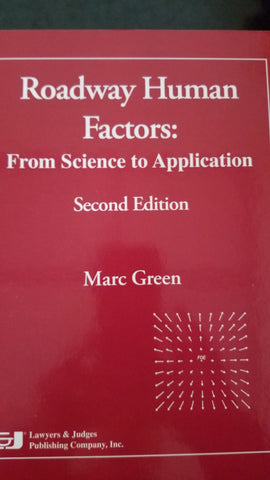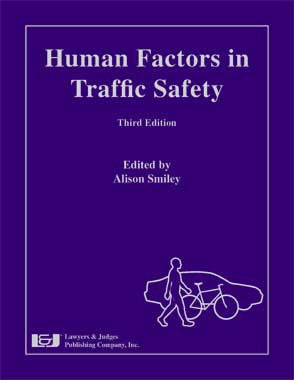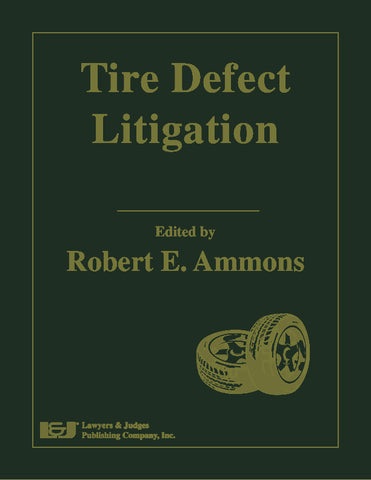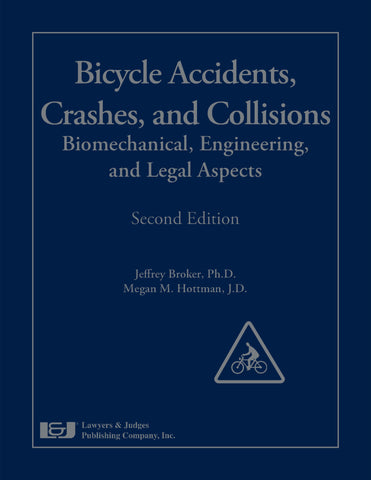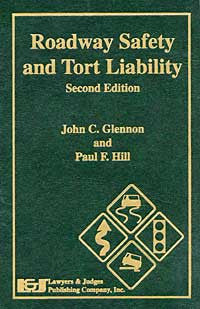
Roadway Safety and Tort Liability, Second Edition
- Author: John C. Glennon, Paul F. Hill
- ISBN 10: 1-930056-94-X
- ISBN 13: 978-1930056-94-7
- Copyright Date Ed: June 1, 2004
- Pages: 698 pages
- Binding Information: Casebound
-
Size: 6 ✕ 9 Inches (US)
Roadway Safety and Tort Liability, the second edition of Roadway Defects and Tort Liability, provides you with an extensive review of roadway design, traffic safety and legal cases. You will review the numerous attempts made to reduce the number of traffic accidents on our roadways and you will understand that although cars are safer for the occupants, driver education has improved and roadway design has advanced, there are still faulty practices and applications that continue to persist on American roadways and railroad crossings.
This new edition has been expanded into two sections. The first section, written by John C. Glennon, D.Engr, P.E, one of the world’s leading roadway experts, examines the various components that make a road either safe or unsafe, from signals and signs to traffic barriers and pavement edge drops. It will give you many valuable insights on the roadway design, roadway maintenance, traffic engineering, and human factor aspects of roadway and traffic safety. Glennon’s chapters review the prevailing and historical standards, accident circumstances, elements of hazard, technical aspects of roadway defects cases and rules of thumb. His section is loaded with photos, graphs and tables that illustrate not only design defects but also defects caused by aging barriers, construction zones, potholes, debris and insufficient signage. By reading through the first section of this book, it becomes clear to you how these defects lead to trouble for motor-vehicle operators.
Section II, by Paul Hill, is comprised of entirely new material. You will be provided an overview of actual suits brought against states, municipalities and cities for accidents claimed to have been caused because of a defect with the roadway. Each chapter in this new section is dedicated to court cases involving one or more of the roadway safety topics discussed in the first section of the book. You will be able to review cases that involve accidents caused by missing signals, debris, traffic barriers, shoulder drop-offs, trees and more. Where applicable, cases from various states are cited to give you an insight into different states’ laws. Moreover, Mr. Hill discusses the court’s opinion and offers an explanation to why judgements were granted in some and denied in others.
As if that is not enough, you will also receive a copy of both the 2001 and 2003 Manual on Uniform Traffic Control Devices on CD-ROM and the Code of Federal Regulations (a value of $69.00) absolutely FREE. With this information you will be able to review the standards, options, guidance and support that government entities and transportation professionals use to make decisions about roadway design and traffic control devices. This all-inclusive package will be essential for any case relating to roadway safety.
Topics include
- Rail-highway grade crossing
- Overview of roadway safety and tort liability
- Roadside safety
- Traffic barriers
- Slippery pavement and hydroplaning
- Intersection sight distance
- Roadway maintenance
- Traffic control devices
- Construction zones
- Pavement edge drops
- Collisions with wild animals
Table of Contents
Part One
1. An Overview of Roadway Safety and Tort Liability
1.1 Diagnosing the Traffic Safety Problem
1.2 Driver Performance
A. Information handling
B. Driver perception-reaction time
1.3 Driver Expectancy, Roadway Consistency and Positive Guidance
A. Driver expectancy
B. Roadway consistency
C. Positive guidance
1.4 Nature of Roadway Defects Today
1.5 Basic Legal Concepts
A. Negligence
B. Contributory versus comparative negligence
C. Joint and several liability
D. Standard of care
E. Notice of a defect
F. Sovereign immunity
G. Governmental versus proprietary functions
H. Discretionary versus ministerial acts
I. Design immunity
1.6 Authoritative Sources of Information
A. Roadway design
B. Roadway maintenance
C. Traffic control devices
D. Work zone safety
E. Roadside safety
F. Rail-highway grade crossings
1.7 The Intended Focus of This Book
2. Roadside Safety
2.1 Characteristics of Single-Vehicle Collisions
2.2 Characteristics of Roadside Encroachments
2.3 A Roadside Hazard Model
2.4 Clear Zone Standards
2.5 Functional Roadside Elements
A. Roadside slopes
B. Bridges
C. Drainage facilities
D. Light poles
E. Sign supports
F. Traffic signal supports
G. Curbs
2.6 Non-Functional Roadside Elements
A. Trees
B. Utility poles
C. Traffic barriers
D. Other fixed objects
2.7 Technical Aspects of Roadside Hazard Cases
A. Roadway widening projects that sacrifice roadside safety
B. Steep side slopes
C. Removable objects within the clear zone <br>D. Moveable objects within the clear zone
E. Non-breakaway functional objects within the clear zone
F. Unprotected functional objects within the clear zone
G. Defective traffic barriers
H. Pavement edge drops
2.8 Typical Defense Arguments
3. Traffic Barriers
3.1 Roadside Barriers
A. Performance
B. Warrants
C. Designs
D. End treatments
E. Placement
3.2 Bridge Rails
A. Performance
B. Designs
C. Transitions
D. Retrofitting substandard bridge rails
3.3 Median Barriers
A. Warrants
B. Designs
C. End treatments
D. Transitions
E. Placement
3.4 Crash Cushions
A. Concept
B. Designs
C. Placement
3.5 Technical Aspects of Traffic Barrier Defect Cases
A. Design versus maintenance function
B. Collision repair
C. Guardrail defects
D. Bridge rail defects
E. Median barrier defects
F. Crash cushion defects
3.6 Typical Defense Arguments
4. Stopping Sight Distance
4.1 Historical Perspective
4.2 Stopping Sight Distance Design Standards
4.3 Accident Experience with Restricted Stopping Sight Distance
4.4 Functional Analysis of Stopping Sight Distance Requirements
4.5 Decision Sight Distance Design Standard
4.6 Technical Aspects of Stopping Sight Distance Defects Cases
A. Hillcrests with deficient SSD on narrow roadways
B. Hillcrests with deficient SSD that hide nearby intersections
C. Sharp roadway curves hidden by SSD-restricted hillcrests
D. Hidden Stop signs
E. A project to flatten a SSD-restricted hillcrest can produce no safety benefit
F. Sharp roadway curves with restricted SSD
G. Sharp roadway curves on freeways with a concrete median barrier
4.7 Accident Reconstruction Aspects
4.8 Typical Defense Arguments
5. Intersection Sight Distance
5.1 Sight Distance Requirements for Uncontrolled Intersections
5.2 Sight Distance Requirements for Stop-Controlled Intersections
5.3 Rail-Highway Grade Crossing Sight Distance
5.4 Technical Aspects of Intersection Sight Distance Defect Cases
A. Uncontrolled intersections with deficient sight distance
B. Stop-controlled intersections with sight restrictions
C. Sight obstructions at freeway interchanges
D. Sight obstructions at driveways
5.5 Accident Reconstruction Aspects
5.6 Typical Defense Arguments
6. Slippery Pavements and Hydroplaning Sections
6.1 Design and Construction of Pavements
6.2 Mechanics of the Tire-Pavement Interface
6.3 Frictional Requirements of Traffic
6.4 Measurement of Pavement Skid Resistance
6.5 Accidents on Wet Pavements
6.6 Standards for Skid Resistance
6.7 Hydroplaning
A. Mechanics of hydroplaning
B. Pavement texture
C. Pavement drainage
D. Pavement wheel ruts
E. Vehicle tires
6.8 Technical Aspects of Slippery Pavement or Hydroplaning Cases
6.9 Accident Reconstruction Aspects
6.10 Typical Defense Arguments
7. Pavement Edge Drops
7.1 Characteristics of a Pavement Edge Drop Traversal
7.2 Writings and Research on Pavement Edge Drops
A. Ivey and Griffin (1976)
B. Nordlin, Parks, Stoughton and Stoker (1976)
C. Klein, Johnson and Szostak (1977)
D. Zimmer and Ivey (1982)
E. Graham and Glennon (1984)
F. Glennon (1985)
G. Olson, Zimmer and Pezoldt (1986)
H. Ivey and Sicking (1986)
I. Ivey, Mak, Cooner and Marek (1988)
J. Humphreys and Parham (1994)
7.3 Recommended Standards for Pavement Edge Drops
A. Recommended practices for normal maintenance
B. Recommended contract provisions for resurfacing roadways
C. Recommended practices for construction zones
7.4 Technical Aspects of Pavement Edge Drop Cases
7.5 Typical Defense Arguments
8. Rail-Highway Grade Crossings
8.1 Accident Statistics
8.2 Legal Responsibilities of Railroads and Roadway Agencies
8.3 Legal Requirements of Drivers at Crossings
8.4 Stages of the Rail-Highway Grade Crossing Maneuver
8.5 Vehicle-Train Conflict Circumstances
8.6 Driver Needs
A. Sight-restricted crossing
B. Roadway intersections close to the crossing
C. Sharp crossing-intersection angle
D. Poor visibility of the train at night
E. Lack of preview of the crossing
F. Rough crossings
G. Steep crossing approaches
H. Appearance of abandonment
8.7 Traffic Control Devices for Rail-Highway Grade Crossings
A. Crossbuck signs
B. Advance warning signs
C. Pavement markings
D. Turn prohibition signs
E. Stop or Yield signs
F. Flashing light signals
G. Automatic gates
H. Train detection
I. Traffic signals near grade crossings
8.8 Sight Distance Requirements
A. Moving roadway vehicle
B. Stopped roadway vehicle
8.9 Rail-Highway Grade Crossing Improvements
A. Eliminate crossings
B. Remove devices at abandoned crossings
C. Improve sight-restricted crossings
D. Bring crossings up to standard
E. Install flashing light signals
F. Install automatic gates
G. Add cantilever signals
H. Install active advance warning signs
I. Install Do Not Stop On Tracks sign
J. Install turn prohibition signs
K. Install warning bells
L. Install crossing illumination
M. Improve roadway horizontal alignment
N. Improve roadway vertical alignment
O. Improve roadway cross-section
P. Improve crossing surfaces
Q. Improve train conspicuity
R. Reduce roadway speed limit
S. Reduce track speed limit
T. Install combinations of improvements
8.10 Technical Aspects of Rail-Highway Grade Crossing Defect Cases
A. Sight triangle obstructions
B. Nearby intersections
C. Sharp angle crossing approach
D. Poor maintenance of signs
E. Lack of advance warnings
F. Poor flashing signal visibility
G. Steep crossing grade
H. Rough crossings
8.11 Accident Reconstruction Aspects
A. Train braking performance
B. Crush damage method
8.12 Typical Defense Arguments
9. Roadway Curves
9.1 Vehicle Cornering
9.2 Tire Pavement Skid Resistance
9.3 Roadway Curve Design Standards
A. Safe side friction factors
B. Maximum superelevation rates
C. Minimum curve radius
9.4 Roadway Curve Accident Characteristics
9.5 Signing for Roadway Curves
A. Curve and Turn signs and Advisory Speed plates
B. Combination curves
C. Supplementary curves signs
9.6 Delineation for Roadway Curves
9.7 Technical Aspects of Roadway Curve Defect Cases
A. Narrow roadway
B. Sight obstructions on roadway curves
C. Tangent roadway with false visual cues
D. Low or negative superelevation
E. Rough or uneven pavements
F. Slippery pavements
G. Other elements
9.8 Accident Reconstruction Aspects
9.9 Typical Defense Arguments
10. Construction and Maintenance Zones
10.1 Fundamental Principles
10.2 Traffic Operational Elements
A. Tapers
B. Detours and diversions
C. One-way traffic control
D. Flagging
E. Mobile operations
F. Pedestrian safety
G. Worker safety
H. Typical applications
10.3 Traffic Control Devices
A. Regulatory signs
B. Road closure signs
C. Warning signs
D. Detour signs
E. Channelizing devices <br>F. Warning lights
G. Advance warning arrow displays
H. Pavement markings
I. Temporary traffic signals
10.4 Technical Aspects of Construction or Maintenance Zone Defect Cases
10.5 Typical Defense Arguments
11. Traffic Control Devices
11.1 Traffic Control Device Requirements
A. Design
B. Placement
C. Operation or application
D. Maintenance
E. Uniformity
11.2 Driver Information Needs
11.3 Traffic Signs
A. Stop signs
B. Yield signs
C. Warning signs
D. Road closure signs
E. Wrong-way traffic control
11.4 Traffic Markings
A. Longitudinal lines
B. Transverse pavement markings
C. Object markers
D. Roadway delineators
11.5 Traffic Signals
A. Traffic signal warrants
B. Number and arrangement of lenses per signal face
C. Flashing signals
D. Size of signal lenses
E. Locations and visibility of signal faces
F. Height of signal faces
G. Shielding of signal faces
H. Signal out of operation
I. Yellow phase-change intervals
J. Pedestrian∂s signal needs
K. Hazard identification beacon <br>L. Intersection control beacon
M. Left-turn signal displays
11.6 The 1988 MUTCD at Court
A. MUTCD word meanings
B. MUTCD contradictions
C. Lack of continuity
D. Plaintiff versus defendant
1.7 The 2000 and 2003 MUTCDs at Court
11.8 Technical Aspects of Traffic Control Device Defect Cases
A. Hidden traffic signs
B. Illusive traffic signs
C. Nonreflective signs
D. Failure to warn
E. Wrong sign for location
F. Unclear messages
G. Nonstandard traffic signs
H. Damaged traffic signs
I. Warning sign in only one direction
J. Partially obscured signs
K. Signs that directly indicate negligence
L. Missing End of Road markers
M. Obstructions in the roadway
N. Missing or faded pavement markings
O. Isolated traffic signals
P. Signal visibility defects
11.9 Typical Defense Arguments
12. Roadway Maintenance
12.1 Unpaved Surface Maintenance
A. Corrugations
B. Wheel ruts
C. Soft spots
D. Dust
E. Potholes
12.2 Asphalt Pavement Maintenance
A. Corrugations and shoving
B. Potholes
C. Upheavals and settlements
D. Flushing
E. Cracks
F. Pavement edge drops
G. Wheel ruts
H. Aggregate polishing
II. Debris on the pavement
12.3 Concrete Pavement Maintenance
A. Surface texture distress
B. Scaling
C. Crack and joint distress
D. Spalling
E. Blowups
F. Frost heaves
G. Pumping
H. Pavement edge drops
I. Debris on the pavement
12.4 Shoulder Maintenance
A. Earth shoulders
B. Sod shoulders
C. Aggregate surfaced shoulders
D. Surface treated shoulders
E. Paved shoulders
F. Maintenance of pavement edge drops
12.5 Roadside Drainage and Vegetation Maintenance
A. Drainage facilities
B. Vegetation control
C. Roadside hazard control
12.6 Traffic Barrier Maintenance
A. Guardrails
B. Bridge rails
C. Median barriers
D. Crash cushions
12.7 Traffic Control Device Maintenance
A. Traffic signs
B. Traffic markings
C. Traffic signals
D. Roadway lighting
12.8 Snow and Ice Control
A. Winter maintenance policies and plans
B. Storm watch
C. Training
D. General maintenance procedures
E. Snow plowing
F. Chemical and abrasive application
12.9 Technical Aspects of Maintenance Defect Cases
A. Washboard, wheel ruts and holes on unpaved roadways
B. Windrows of gravel on unpaved roadways
C. Dust on unpaved roadways
D. Roughness, potholes, and bumps on paved roadways
E. Gravel on the pavement
E. Flooded pavements
F. Soft shoulders
G. Icy bridges
H. Sight distance obstruction created by snow plowing
I. Snow-plow cloud
J. Hydroplaning sections in the winter
12.10 Typical Defense Arguments
Part Two
13. Introduction to Part Two
A. How This Part of the Book Was Researched and Written
B. Governmental Immunity
C. Discretionary and Ministerial Functions
D. Notice: Actual or Constructive
E. Identifying Whom to Claim Against
F. Government Has a Non-delegable Duty.
G. Government Is Not an Insurer of Safety
14. Traffic Signs: Decision to Install, Missing, Obscured, or Improper
15. Traffic Signals: Decision to Install, Timing, Inoperable or Improper
16. Curves
17. Potholes and Other Surface Defects
18. Ice, Snow, Sand, Gravel, Oil, or Water on the Road
19. Shoulder, Drop-Off, and Beyond the Shoulder
20. Traffic Barriers: Guardrails, Bridge Rails, and Median Barriers
21. Trees, Poles, Posts, Support Columns, Vegetation Obstructing View
22. Railroad Crossing
23. Objects Thrown, Dropped, or Falling from Bridge or Overpass
24. Collisions with Deer and Other Wild Animals on the Road

